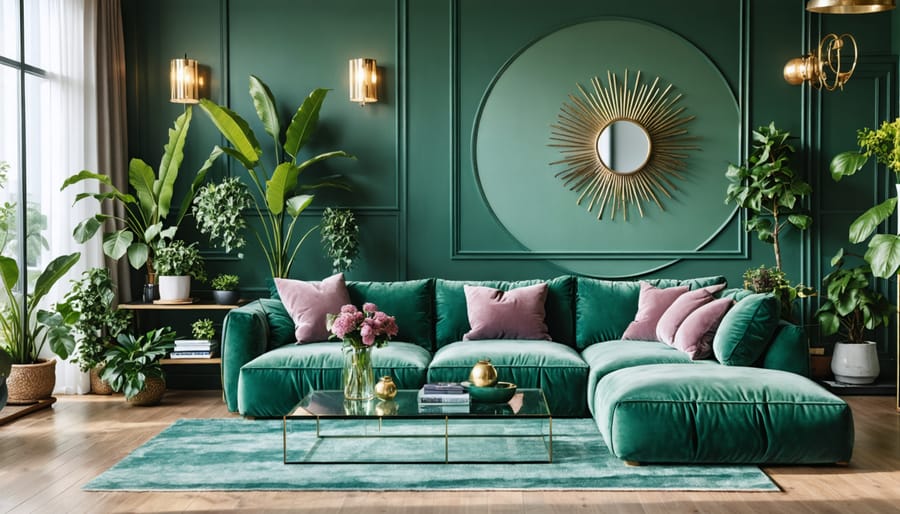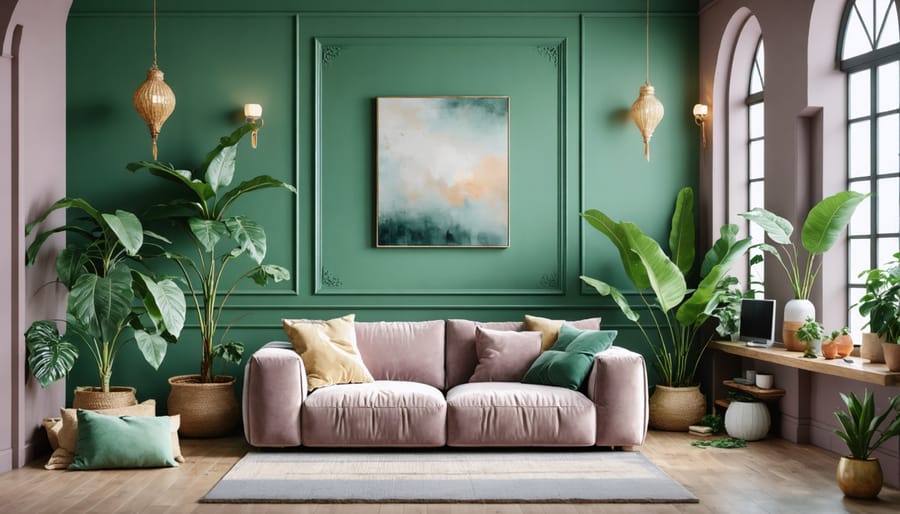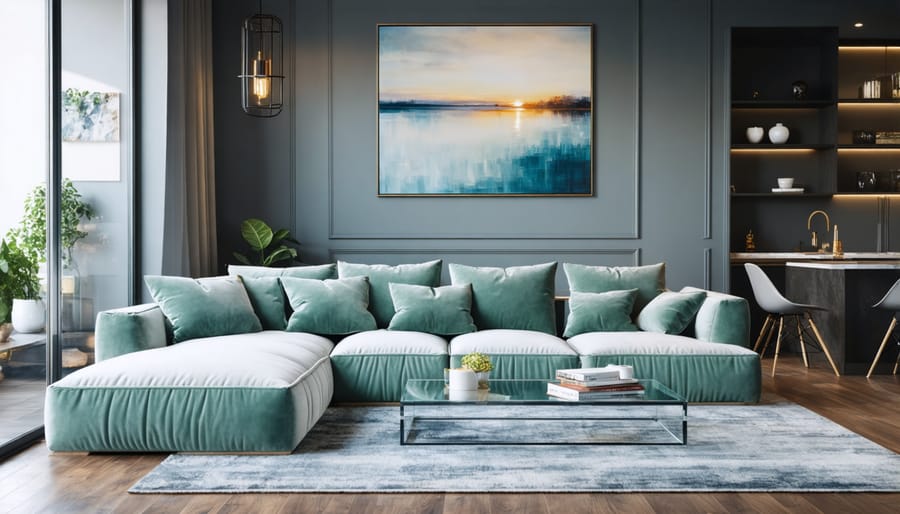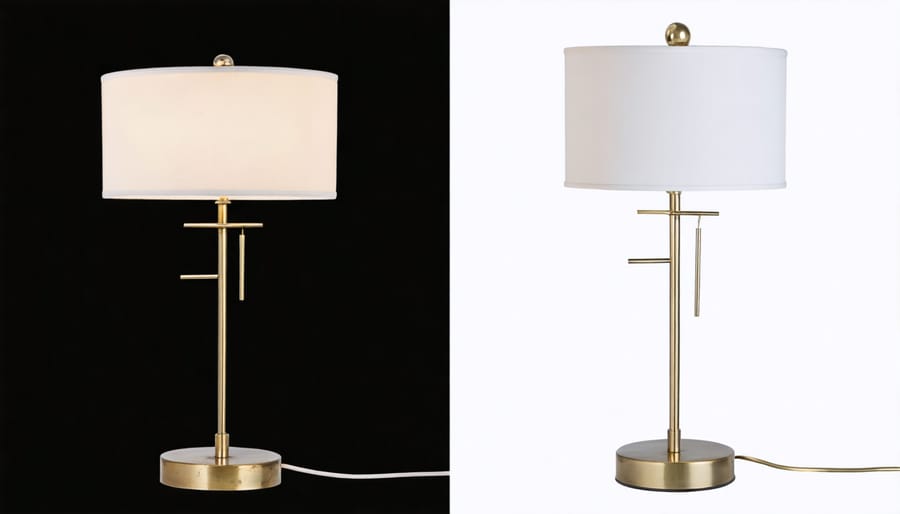
90s Interior Design is Back: How to Rock the Revival Without Looking Dated
The bold patterns and playful aesthetics of 90s interior design are making a stunning comeback, transforming modern spaces with their distinctive charm. By incorporating timeless vintage elements like Memphis-inspired geometric shapes and pastel color palettes, today’s homeowners are reimagining this nostalgic decade with fresh sophistication. The 90s design renaissance celebrates both minimalist zen spaces and maximalist statements, offering versatile inspiration for contemporary homes. From sunburst mirrors and abstract art to translucent furniture and bold botanical prints, these retro design choices create spaces that feel both nostalgic and remarkably current. This revival isn’t just about recreating the past – it’s about cherry-picking the decade’s most innovative elements and adapting them for modern living, proving that great design truly transcends time.
The Essence of 90s Interior Design
Color Palettes That Defined the Era
The 90s palette was distinctly earthy and muted, with hunter green reigning supreme as the decade’s defining color. This deep, rich shade appeared everywhere from wallpaper to upholstery, often paired with burgundy and navy blue to create a sophisticated look. Mauve, a dusty rose-purple hybrid, dominated living rooms and bedrooms, while warm beige acted as the neutral backdrop for these bolder choices.
Southwestern-inspired terracotta and desert sand tones gained popularity mid-decade, reflecting the era’s fascination with natural elements. These were frequently accented with teal and salmon pink, creating that quintessential 90s vibe. Golden oak, a yellowish-brown wood tone, became ubiquitous in homes thanks to the widespread use of oak cabinets and furniture.
For those looking to incorporate 90s colors today, try using hunter green as an accent wall or mauve in smaller doses through textiles and accessories. The key is balancing these distinctive hues with contemporary neutrals to avoid a dated appearance while still capturing the decade’s cozy, grounded aesthetic.

Signature Materials and Textures
The 90s brought a distinctive mix of materials and textures that defined the era’s interior design aesthetic. Brass fixtures and hardware dominated the scene, appearing on everything from door handles to light fixtures, offering a warm metallic glow that contrasted beautifully with the decade’s bold color schemes. Glass blocks became a architectural statement piece, especially in bathrooms and room dividers, creating privacy while allowing natural light to filter through.
Floral patterns reigned supreme on upholstery and window treatments, featuring oversized blooms in muted pastels or bold jewel tones. These patterns often incorporated busy designs with multiple colors and intricate details. Textured wallpapers added depth to rooms, with favorites including grasscloth, vinyl papers with raised patterns, and faux finish effects that mimicked marble or stone.
Velvet and chenille fabrics were particularly popular for furniture, while heavily textured berber carpeting covered floors. Faux finishing techniques, like sponging and ragging, added visual interest to walls, while high-gloss lacquer finishes on furniture pieces provided a sleek, contemporary touch that defined the decade’s more sophisticated spaces.
Modern Takes on 90s Furniture Styles
Statement Pieces Worth Bringing Back
The ’90s brought us some iconic furniture pieces that are making a surprising comeback in modern homes. Sectional sofas, those modular seating arrangements that could accommodate the whole family, are experiencing a renaissance with updated fabrics and sleeker profiles. Today’s versions maintain the comfort and versatility of their ’90s predecessors while incorporating contemporary design elements like clean lines and neutral colors.
Glass tables, particularly those with brass or chrome accents, were a ’90s staple that’s worth reconsidering. Modern interpretations feature tempered glass with sophisticated metal finishes, offering the same light-reflecting properties that made them popular while fitting seamlessly into current design schemes. These pieces work especially well in smaller spaces where visual lightness is key.
Perhaps the most nostalgic piece is the entertainment center. While the original bulky units designed for massive tube TVs are gone, today’s entertainment centers have evolved into sleek media consoles that pay homage to their ancestors while addressing modern needs. Look for pieces that combine open shelving with hidden storage, perfect for organizing gaming consoles, streaming devices, and sound systems while maintaining a clean aesthetic.
When incorporating these statement pieces, remember that less is more. Choose one or two elements rather than recreating an entire ’90s room, and pair them with contemporary accessories to create a balanced, updated look that nods to the past without being stuck in it.
Contemporary Updates to 90s Classics
Today’s design enthusiasts are breathing new life into 90s furniture classics, creating a fresh modern vintage style that honors the past while embracing contemporary aesthetics. The iconic oversized sectional sofa, for instance, has evolved from its bulky predecessor into a streamlined version with clean lines and performance fabrics, while maintaining its original comfortable appeal.
Glass block walls, a 90s staple, are making a comeback with slimmer profiles and creative installation patterns that create striking light effects. Instead of the traditional clear blocks, designers now incorporate colored or textured options for added visual interest.
The beloved entertainment center has transformed into floating media walls with built-in LED lighting and hidden cable management systems. These updated versions maintain the focal point status of their predecessors while offering a more sophisticated, clutter-free appearance.
Brass fixtures, another 90s favorite, have returned with a modern twist. Rather than the shiny, lacquered finish of the past, today’s brass elements feature brushed or aged patinas that add warmth without appearing dated. Similarly, floral patterns have been reimagined with larger, more abstract designs and contemporary color palettes that feel fresh and current.
Wood furniture pieces from the 90s are being upcycled with modern finishes like chalk paint or two-tone treatments, proving that yesterday’s pieces can seamlessly integrate into today’s interiors with thoughtful updates.

DIY 90s Design Elements
Weekend Makeover Projects
Transform your space with these quick and budget-friendly 90s-inspired weekend projects. Start by creating a Memphis-style accent wall using geometric shapes in bold colors like teal, hot pink, and yellow – all you need is painter’s tape and acrylic paint. For an authentic 90s vibe, try sponge painting a feature wall using complementary colors for that distinctive textured look.
Give old furniture pieces new life with some neon spray paint, or add squiggly decals to plain surfaces for instant 90s flair. Create a retro wall collage using magazine cutouts, CD covers, and polaroid photos – perfect for teenagers’ rooms or home offices. For a subtle touch, paint plant pots in pastel colors and add zigzag patterns.
Transform plain throw pillows with fabric paint in geometric patterns, or tie-dye existing white textiles in classic 90s color combinations. Install stick-on holographic wall decals for that space-age feel, or create a retro bulletin board using cork and neon washi tape.
For the ultimate 90s touch, string up some clear globe lights and add glow-in-the-dark stars to your ceiling. These projects can be completed in a weekend and won’t break the bank, letting you experiment with 90s style without committing to major renovations.
Thrifting Tips for Authentic 90s Pieces
Looking to score authentic 90s pieces without breaking the bank? The retro design revival has made thrifting for 90s decor more exciting than ever. Start by exploring local thrift stores, estate sales, and flea markets early in the morning for the best finds. Keep an eye out for signature pieces like Memphis-style lamps, abstract art prints, and clear acrylic furniture.
When evaluating potential purchases, check for quality markers like original tags, manufacturing stamps, and period-appropriate materials. Don’t overlook pieces that need minor TLC – a quick cleaning or fresh coat of paint can transform dated items into stunning statement pieces.
Online marketplaces like Facebook Marketplace, Etsy, and eBay are goldmines for specific 90s items, but always request detailed photos and ask about any damage before purchasing. For furniture restoration, focus on preserving original finishes when possible, and use period-appropriate hardware for repairs.
Pro tip: Create a mood board of authentic 90s interiors to help identify genuine pieces versus modern reproductions. Remember, some wear and patina can add character – don’t pass up a great piece just because it’s not perfect.

Avoiding Common 90s Design Mistakes
Balance is Key
The key to successfully incorporating 90s design elements into modern spaces lies in striking the perfect balance between nostalgia and contemporary style. Rather than fully recreating a 90s room, focus on creating bold contrasts between vintage and modern pieces. Start by selecting one or two statement 90s elements, such as a Memphis-inspired accent chair or geometric wallpaper, and pair them with clean, contemporary furniture and finishes.
Consider the 60-30-10 rule when mixing decades: 60% modern elements, 30% 90s-inspired pieces, and 10% eclectic accessories that bridge the two eras. This prevents your space from feeling like a time capsule while still capturing that coveted retro vibe. For example, combine a sleek modern sofa with 90s-style neon artwork and abstract throw pillows.
The secret to successful integration often lies in color coordination. If you’re incorporating bold 90s patterns or colors, balance them with neutral, contemporary elements. A pastel Memphis-style side table can work beautifully against a crisp white wall, while chunky 90s furniture pieces can be updated with modern upholstery in current colorways. Remember that lighting plays a crucial role – modern fixtures can help ground vintage elements and create a cohesive look that feels intentional rather than dated.
What to Skip from the 90s
While the 90s brought us many cherished design elements, some trends are better left in the past. The infamous wall-to-wall carpeting in bathrooms not only posed practical problems but also created moisture-related issues. Those busy, overwhelming wallpaper borders that wrapped around entire rooms should stay firmly in the previous century, along with their matching window valances.
Sponge painting and faux finishing techniques, while creative, often resulted in messy, dated-looking walls that are difficult to cover up. The overuse of hunter green and burgundy color combinations, particularly in heavy fabric choices, can make spaces feel dark and oppressive by today’s standards.
Avoid the chunky, oversized furniture sets that dominated 90s living rooms, especially those featuring busy floral patterns or thick stripes. The abundance of artificial silk plants and trees, usually covered in dust, is another trend best forgotten. Country-style wooden signs with cutesy sayings and mass-produced “live, laugh, love” decorations should also remain in the past.
Pine furniture, particularly when featuring that distinctive orange-yellow finish, can make spaces feel outdated. Similarly, lacquered brass fixtures and cabinet hardware have been replaced by more sophisticated metallic finishes. Finally, those themed rooms that went all-in on specific motifs (like the complete Southwest look or nautical everything) are best avoided in favor of more subtle, curated approaches to decor.
The 90s interior design revival offers a perfect blend of nostalgia and modern sensibility that can transform any space into something truly unique. By incorporating key elements like bold geometric patterns, Memphis-inspired designs, and minimalist influences, you can create a space that pays homage to this vibrant decade while maintaining contemporary appeal.
Remember that successful 90s-inspired design isn’t about recreating the decade exactly as it was, but rather choosing the best elements that resonate with today’s aesthetic sensibilities. Whether you opt for a subtle nod through pastel accents and curved furniture, or go all-in with neon signs and bold color blocking, the key is to balance these retro touches with modern elements.
Don’t be afraid to experiment with different combinations of 90s design elements. Start small with decorative accessories or a statement wall, and gradually build your confidence to tackle larger projects. The beauty of 90s design lies in its versatility – it can be as subtle or as dramatic as you desire.
Most importantly, make the style your own. The 90s were all about self-expression and breaking design rules, so use this spirit as inspiration while creating a space that reflects your personal taste. With thoughtful planning and creative vision, you can successfully blend the charm of 90s design with contemporary comfort and functionality.
